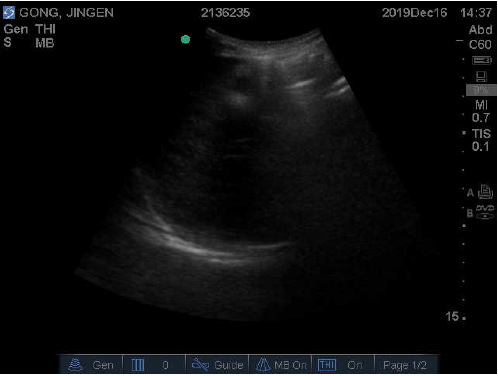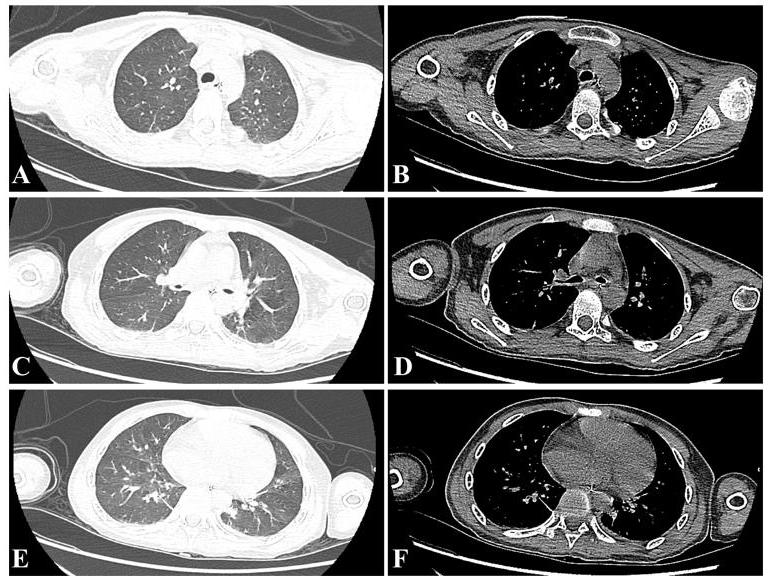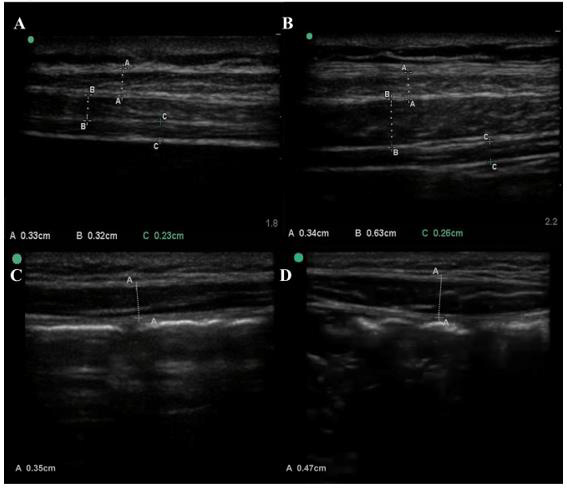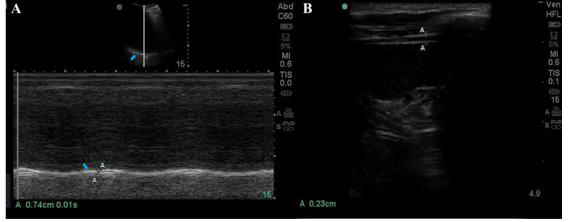The Challenge Management of a Child with Cervical Spinal Cord Injury with Ultrasound Assessment of Respiratory Muscle: A Pediatric Case Report
Introduction
Traumatic spinal cord injury (SCI) is commonly encountered and managed in the emergency department and the intensive care unit (ICU). More than 80% of traumas are caused by falls from height and road traffic accidents [1,2], and approximately 50% of the SCI are sustained at the cervical level that leads to severe high-level quadriplegia. Many of these patients develop respiratory compromise and respiratory failure, which require prolonged mechanical ventilatory support. Compromise in respiratory function remains the most common cause of mortality following a SCI [3]. The abdominal muscles comprise of transversus abdominis (TrA), internal oblique (IO), external oblique (EO), and rectus abdominis (RA). Together with the diaphragm, these muscles play a key role in regulating intra-abdominal pressure and assisting in activities including defecation, vomiting, coughing, sneezing, and childbirth [4,5]. Therefore, the evaluation of the function of the diaphragm and abdominal muscles is paramount in the management of SCI.
Studies have reported that the diaphragmatic and abdominal muscular functions can be assessed indirectly by ultrasound scan, which has the advantages of being a non-invasive, radiation-free, easily implementable, and reproducible assessment tool [6,7]. Here, we described a patient with SCI at the cervical level resulting in high-level quadriplegia and respiratory failure, which was complicated by pulmonary infection. We demonstrated the use of the point-of-care ultrasound (POCUS) in the management of this patient at the department of critical care medicine (CCM), which was beneficial in the monitoring of diaphragmatic and abdominal muscular functions and predicting the ultimate clinical outcome.
Case Presentation
A 12-year-old Chinese male sustained a cervical SCI (odontoid fracture associated with atlantoaxial dislocation) following a fall. Consequently, he developed high-level quadriplegia and was dependent on invasive mechanical ventilatory support. The physical examination revealed muscle strength grade 0 in the extremities, partially sensory but not motor function is preserved below the neck [ASIA (American Spinal Cord Injury Association) B classification]. He underwent an emergency open reduction and internal fixation for the odontoid fracture of C2. He was then transferred to the department of CCM for continuing respiratory support [synchronized intermittent mandatory ventilation with pressure support (SIMV+PS), respiratory rate (RR) 16/ min, pressure control (PC) 10cmH2O, PS 10cmH2O, positive endexpiratory pressure (PEEP) 5cmH2O, FiO2 30%] and further management. The arterial blood gas analysis revealed pH 7.378, PaO2 121.2mmHg, PaCO2 41.2mmHg, HCO3- 23.7mmol/L, and lactate 0.8mmol/L. The thoracic CT (computed tomography) scan showed a few infectious lesions and infiltrating shadows of both lungs (Figure 1).
Figure 1: CT images of the patient demonstrating a few infectious lesions and infiltrating shadows of both lungs.
Considering the requirement for prolonged mechanical ventilator support, a tracheotomy was performed on day-4 following the admission to the department of CCM. On day-5, an ultrasound scan was performed to measure the diaphragmatic motion (convex-array transducer [3-5 MHz] in M-mode) at the level of the midclavicular line of the subcostal region, and the diaphragmatic thickness (linear-array probe (>10 MHz) in B-mode) and thickening rate (linear-array probe (>10 MHz) in M-mode) at the mid-axillary line of the thoracic cage [5,8]. As demonstrated in Figure 2A, the diaphragm showed little movement and was depicted as a straight line in M-mode. The motion was almost zero. The diaphragm thickness measured approximately 0.22 cm during expiration (Figure 2B), which remained constant with respiratory movement, with both the thicknesses at the inspiratory phase and respiratory phase measuring at 0.2cm in M-mode (Figure 2C). The muscle thicknesses of TrA (0.23cm), IO (0.32cm), EO (0.33cm), and RA (0.35cm) were clearly observed and measured in B-mode (Figures 3A & 3C) at the midpoint between the inferior angle of the rib cage and the iliac crest and 2cm above the umbilicus at the level of the midclavicular line [5,9].
Figure 2: Ultrasound imaging of the patients’ diaphragm. A, Diaphragmatic motion during breathing at rest in M-mode. The echogenic line (blue arrow) indicated the diaphragm. B, Diaphragmatic thickness (the distance between A-A) during expiration in B-mode. C, Diaphragmatic thickening rate in B-mode. The A-A points indicated the diaphragm thickening during inspiration, and the B-B points indicated the diaphragm thickening during expiration.
Figure 3: Ultrasound imaging of the thickness of the abdominal muscles measured in B-mode at rest at day-5 (A, C) and day- 15 (B, D) following admission to the department of CCM. A, The external oblique (EO, A-A points), internal oblique (IO, B-B points), transversus abdominis (TrA, C-C points), and C, the rectus abdominis (RA, A-A points). B, the external oblique (EO, A-A points), internal oblique (IO, B-B points), transversus abdominis (TrA, C-C points), and D, the rectus abdominis (RA, A-A points).
Upon weighing the potential risks and benefits, with the supports of an external fixator, the patient was assisted to improve expectoration by changing the body position, patting the back, application of vibration row phlegm, and other measures, in addition to daily external electrical phrenic nerve stimulation, guided breathing exercises, and optimization of nutritional support to enhance the strength of the patient’s diaphragmatic and abdominal muscular function to the maximum. On day-15 following the admission to the department of CCM, a repeat scan was performed to re-assess the diaphragmatic and abdominal muscular function during breathing at rest. The muscle thicknesses of the diaphragm, TrA, IO, EO, and RA were 0.26cm, 0.63cm, 0.34cm, and 0.47cm, respectively (Figures 3B & 3D), while the diaphragmatic motion was measured at 0.74 cm (Figure 4A). The dynamic graph of the patient’s diaphragmatic motion was shown in video 1. During expiration, the diaphragmatic thickness was approximately 0.23 cm (Figure 4B).
Figure 4: Ultrasound imaging of the patients’ diaphragm at day-15 following the admission to the critical care unit. A, Diaphragmatic motion during breathing at rest in M-mode. The echogenic line (blue arrow) indicated the diaphragm. The distance between A-A indicated the diaphragm excursion. B, diaphragmatic thickness (the distance between A-A) during expiration in B-mode.
video 1.

When comparing with the initial measurements, the muscle thicknesses of IO and RA had markedly increased, together with a significantly higher diaphragmatic motion during breathing at rest. At the same time, arterial blood gas analysis was reviewed and the results were normal. Further clinical evaluation revealed that the patient could be weaned off the ventilator [ventilator mode: continuous positive airway pressure (CPAP), PS 8cmH2O, PEEP 5cmH2O, FiO2 21%]. Following the repeat scan, the patient was successfully weaned off the ventilator and was discharged from the department of CCM, after a total of 17 days of stay.
Discussion
Many patients with respiratory failure following a cervical SCI are dependent on chronic mechanical ventilation despite intensive respiratory rehabilitation. Our case highlighted the value of POCUS during the period of postoperative rehabilitation, enabling dynamic evaluation of the function of the diaphragm and abdominal muscles. The information generated from the POCUS provided objective recovery status of the patient’s respiratory function, which guided the clinician in decision making in weaning the patient off the ventilator. Respiration is a complex process mediated by the concerted action of the thorax and the abdomen. Normal breathing requires an open airway, intact and well-expanded thorax, lung tissue with good compliance and matching pulmonary artery blood flow, sensitive respiratory nerve center and neurotransmission system, and sound respiratory muscles. The respiratory muscles including the inspiratory muscles (the diaphragm and external intercostal muscles), the expiratory muscles (internal intercostal muscles and abdominal muscles), and the accessory respiratory muscles are essentials in the mechanistic of breathing through mediating intrathoracic pressure thereby altering the lung volume [10,11].
The respiratory compromise in SCI is secondary to the loss of movement of the respiratory muscles below the level of the injury [3]. The diaphragm and abdominal muscles are often overlooked in the ventilatory management and rehabilitation following SCI. The weakness in the action of the diaphragm and abdominal muscles leads to dyspnea and activity intolerance. In addition to generating forces that maintain the stabilization and support the movement of the spinal column, the abdominal muscles collectively pressurize the abdominal cavity. This not only is essential in active exhalation but also partakes in the cough mechanism for the removal of respiratory secretions. Furthermore, the diaphragm represents the main respiratory muscle, which when contracts, the thoracic cavity expands to enable active inspiration. On the contrary, when the diaphragm relaxes, the volume of the thoracic cavity decreases to facilitate exhalation. Synchronized contraction of both the diaphragm and abdominal muscles increases the intra-abdominal pressure, which assists in defecation, cough, removal of respiratory secretions, and other activities [5].
The deficiency in these functions is usually difficult to be ascertained and often delayed in the diagnosis, given that most screening tools for dyspnea do not encompass the assessment of the functions of the diaphragm and abdominal muscles. Consequently, this is not addressed early and represents a common cause for the failure of patients to be weaned off the ventilator and mortality from severe respiratory complications [12]. In recent years, the use of POCUS has become increasingly popular to assess the diaphragm and abdominal muscles in critically ill patients. Studies have shown that POCUS could accurately assess the thickness of the abdominal muscles and the diaphragm in addition to its thickening rate and motion. Moreover, it is a readily available tool in the critical care unit for performing bedside assessment, which is non-invasive and easily applicable. In our case, POCUS has been utilized to dynamically evaluate the daily functions of the diaphragm and abdominal muscles, guiding the clinicians in making decisions on respiratory rehabilitation and accurately weaning the patient off the ventilator and eventually almost complete recovery.
Conclusion
The optimal function of the diaphragm and abdominal muscles is paramount for effective lung ventilation that is often overlooked in the management of SCI. The routine and repetitive application of POCUS allows the clinician to objectively and dynamically evaluate and monitor the global function of the respiratory muscle pump, which predicts the risk for difficult weaning, weaning failure, and ultimate clinical outcome.
For more Articles on: https://biomedres01.blogspot.com/






No comments:
Post a Comment
Note: Only a member of this blog may post a comment.